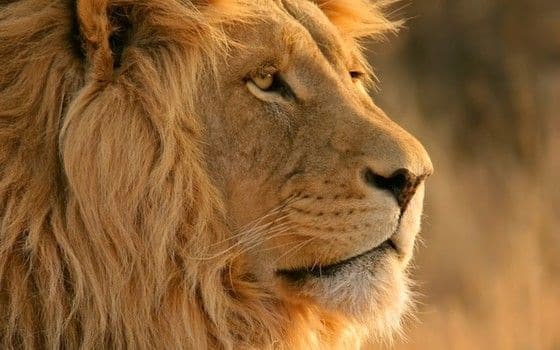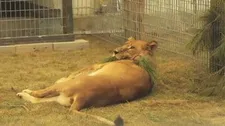 |
| Lion at large. |
In 2009, Bolivia became the first country in South America to ban the keeping of animals in circuses, and the first in the world to properly enforce it. Handling lions is not something the average police officer is trained in, however, so the charity Animal Defenders International (ADI) stepped in to help. Sensing that this was something big, its vice president, Tim Phillips, took along a camera crew. They had no idea how wild a ride it was going to be.
The filmmakers’ efforts have been rewarded. Their documentary, Lion Ark, has just been selected for Raindance, where it will have its UK première on October 1 at the Vue Cinema just off Piccadilly, with an introduction by Brian Blessed. Its US première will take place just four days later at another prestigious event. I caught up with Tim as he was about to catch a flight to L.A., to ask him how he felt about it all.
“We’re very excited to finally get the film out there and being seen by people,” he told me with unmistakable enthusiasm. “We’ve slogged away making t by ourselves for a long time. We’ve really been refining production right up until now because we have quite a complicated audio track – because all the sound work was live – so we’ve spent a lot of the past few weeks refining it and getting it nice and crisp and clear. We’ve also been submitting it to festivals and the first ones are just coming back to us now.”
He was excited, he tells me, as the story developed. From the outset he’d planned to film everything and just see what happened but it soon became apparent that he was capturing something special. It was also something very risky. I ask him how close he was to the action as the film was made.
“We were absolutely hands on,” he assures me, explaining that if the work was ever dangerous it would be he and his wife, ADI president Jan Creamer, who stepped in to handle it. “We’ve done this kind of thing all over the world. Our number one priority was to get the lions free but although Bolivia passed this law there was no sanctuary framework there. If it had been America there might have been somewhere for them to go but as there wasn’t that option we built holding cages as we seized the lions and then we had to arranged to ship them out of there. Obviously security is top priority when you’re dealing with animals that can take your arm off or kill you.”
It didn’t always go to plan. “There was one point where we had to get a very aggressive lion out – the big male, Colo Colo – and he was really ready to kill us. Now, we’ve moved lions and tigers all over the world and we know what we’re doing. We lined all the cages up but then, of course, the door was just rusted shut, and we had no alternative but to go in and battle it. Funnily enough, at that point we weren’t really that scared. We were confident about going in with our team and if we got thumped or bitten by an animal it wouldn’t be the end of the world.”
Some moments, however, were more nerve-racking.
“There was one point where we had to drive through the mountains with the lions. It was a 14 hour journey through very difficult terrain – in the area where Che Guevara used to have his hideout – very remote and unpopulated, and we were on bumpy roads that had basically just been hacked out of the side of the mountains. it was pitch dark even with the headlights and on one side of us was a sheer drop – we literally could not see the bottom. We tried to capture some of that experience in the film but it’s not as vivid as it was in real life. it was such a long journey and all the time we were aware that the crates of lions we were towing were very top-heavy. i think that was the only time I really felt scared, both for our lives and for the lives of the animals.”
Though it might not quite match the feeling of the being there, there’s a real sense of immediacy to events in the film that stems partly from the commentary delivered at the time. “I think everyone looks back on events with rose tinted glasses,” says Tim, explaining why he chose that approach. “Jan is a very passionate campaigner and she’s been interviewed hundreds of times but I think it changes the dynamic to have her speaking right there in front of the animals.”
This technique also creates a sense of danger – it’s not clear if everyone, lions included, will survive until the end of the story. Discussing at the work ADI are undertaking now, Tim reveals that it can often be dangerous, with lions and precipices only part of the equation. They’re currently working in other South American countries which have followed Bolivia’s lead. “Alexis, who did undercover work on our film, was caught filming at a circus at the beginning of last week,” he tells me. The result was a broken leg.
Still, he says, it’s very exciting because they feel that real change is taking place worldwide – not just new laws but a shift in thinking. Greece has now instituted a total ban on keeping animals in circuses and the UK is “teetering on the edge of a ban.” ADI recently won a court case against a circus owner who brutalised an elephant. They hope that she will be the last elephant ever forced to perform in the UK. The shocking scenes of cruelty shown in the film will likely win many more supporters for their cause.
At the end of the film, we are treated to the site of rescued lions exploring their new home in Colorado. Many of these were seriously traumatised animals so adjusting can’t have been easy. I ask Tim how they’re doing now.
 |
| Adjusting to a better home. |
“They’re absolutely fantastic,” he announces happily. “I just visited them a couple of weeks ago – we try to get over there as regularly as we can. We’re still funding their upkeep and we expect to be looking after some of them for 20 years so we’re always fundraising. People can adopt the Lion Ark lions if they like. When we went over we drove out into the enclosure where the Cavalini eight live. They’ve got 25 acres now and a huge underground den. We ere driving through the long grass and we didn’t see any of them at first but then they started popping up, one head after another. All of the females can stalking after our vehicle, chasing and playing and biting the bumper. The whole family was so engaged, it was fantastic.”
He also has news of Colo Colo, the lion who once wanted to kill him. “The transformation of Colo Colo is amazing. He used to be this angry, vicious animals, but since then he’s had massive dental work done so he no longer has all that pain in his face. He lives with Lulu and Monica now and he’s completely relaxed and at peace.”
Watching these lions, he says, recharges his batteries as he prepares for the next project.





















